Posts: 182
Threads: 5
Joined: Feb 2017
City: Cedar Rapids Iowa
Thanks Russ! Just so others can see the comment without needing to go to the page here it is:
"Tried to fix a broken wafer years ago...the super glue traveled down several wafers...everything got frozen...it became a parts set!"
I'm not sure how this could happen unless you were really careless with the super glue. This wafer is separated from the others by over an inch and a half. Of course, you'd have to make sure you kept it away from any of the contacts. Am I missing something?
Rich
Posts: 2,118
Threads: 112
Joined: Jun 2010
City: Medford OR (OR what?)
no. You are probably right. Be careful and aware that super glue might take a while to set.
"I just might turn into smoke, but I feel fine"
http://www.russoldradios.com/
Posts: 182
Threads: 5
Joined: Feb 2017
City: Cedar Rapids Iowa
I think I've found a solution to the broken wafer on the function switch:
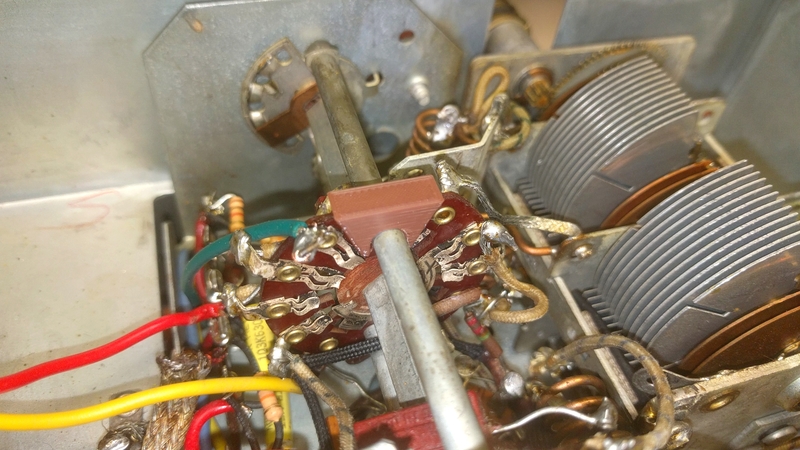
I designed and printed a reinforcement piece on my 3d printer. I plan to apply a small amount of epoxy to the inside surfaces of the 'legs' of the piece and slide it onto the wafer. I still want to come up with a way to apply a little side to side pressure to close the crack while the epoxy sets up.
Rich
Posts: 182
Threads: 5
Joined: Feb 2017
City: Cedar Rapids Iowa
Hey Bill - I don't know why I didn't think of this before, but Michael LaRose did a 14 part series on his YouTube channel (ThatTubeSound) covering his restoration of a 47-1230. Check it out: https://www.youtube.com/watch?v=5vcvh0f4...OyzNZvIj9A
Rich
Posts: 641
Threads: 48
Joined: Mar 2017
City: Gap Mills Wv 24941
i am recalling something,,,
i got help determining my audio output transformer was bad and replaced it.
i still had no sound,,, granted this is well into the resto where i was expecting sound.
i think over at my loctal socket we finally found i had a carbon trace. I only found this by taking readings on each and every pin and paying particular attention to some of those lower voltages and the polarity of the readings showing up as neg & pos voltages.
once we found the carbon trace,,, i ordered some loctal's but headed back out to remove the socket,,, it was out in like 10 minutes.
i continued to dissect the socket cause i wanted to see for myself this mysterious carbon trace everyone was making a big deal about
sure enough the electrons had dug a ditch from a particular pin on through the phenol wafer over to another pin or chassis.
i knew i could attempt a fix so i sanded waffer down on 1000 grit then 2000 grit sand paper till the ditch was gone then put it back together.
in about an hour i had the old socket back in and got sound.
what i did is not recommended and unorthodox but doing so i knew would help me progress to having sound instead of waiting on the mail. I was looking to see if this provided the answer to no sound and it did.
Posts: 69
Threads: 4
Joined: Apr 2016
City: washington nj
Yes Rich, thank you, I've seen it many times. Bill
Posts: 182
Threads: 5
Joined: Feb 2017
City: Cedar Rapids Iowa
I set the chassis for my 47-1230 aside for awhile while I do some more research to see if I can figure out why the FM doesn't work. So I decided to clean and lubricate the phonograph. All of the grease had dried and hardened so it was necessary to completely remove everything for cleaning. That in itself was difficult...the cam gear and the separator post in particular were extremely difficult to remove. Just a note to others that might be considering doing this but are afraid to do it because it looks complex...it really isn't difficult at all. It's just a bunch of levers and springs. Take your time...take lots of pictures...and keep everything organized. That being said, I don't know how difficult it will be to make sure everything is adjusted correctly, but it doesn't look too tough.
Here are before and after shots. The 'before' picture really doesn't show how grungy it was.
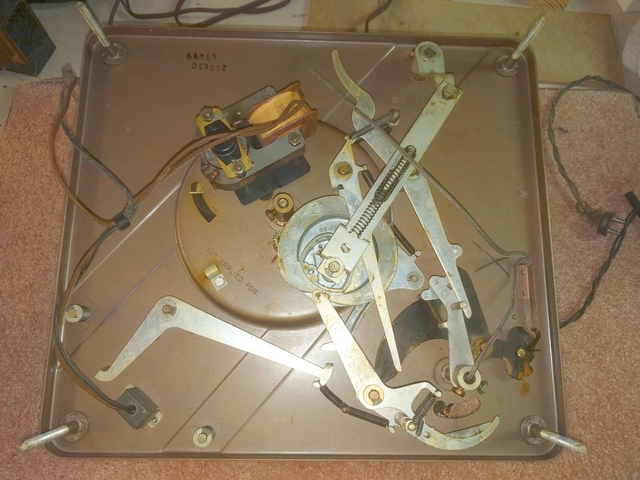
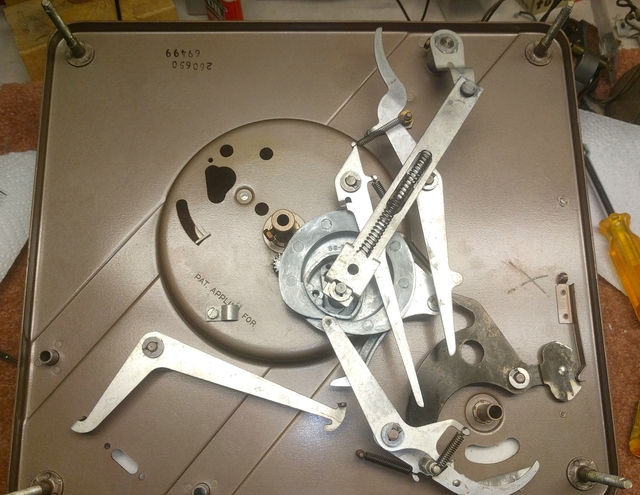
Now for my question. I don't see a way to lubricate the shaft for the pinion gear without taking the gear off. It's held in place on the shaft with a pin. How difficult is it to tap the pin out, remove the gear, lubricate the shaft, replace the gear, and tap the pin back in?
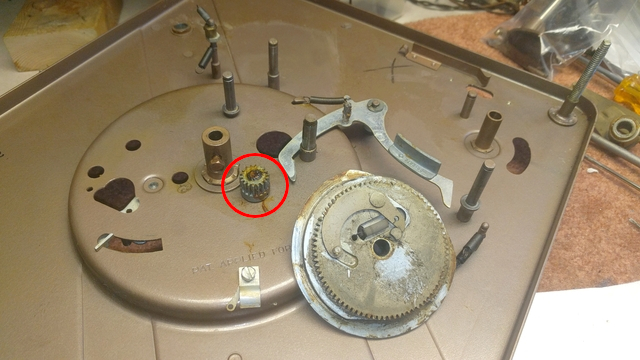
Thanks,
Rich
Posts: 21
Threads: 3
Joined: Dec 2018
City: Davis
State, Province, Country: CA
I've been getting ready to do this myself, and this series of videos (which I'm sure you've seen) really came in handy.
https://www.youtube.com/watch?v=xbC78xI_...9A&index=3
That top gear might be plastic, and I would be very reluctant to mess with that. You might just try to wick in some oil instead, and call it a day there. Pressed in pieces are not very forgiving.
Posts: 182
Threads: 5
Joined: Feb 2017
City: Cedar Rapids Iowa
Thanks Mutantmoose! Yes, I've followed Michael for a long time and watched that series when he posted it, and have reviewed it recently. He does some great work! But I didn't see anywhere in his series where he lubricated either the metal pinion gear (or the cam gear for that matter) or the shaft it's attached to. The plastic gear on top is connected to the same shaft and I have no intention of trying to take it off. But if the metal gear was removed, the plastic gear would come out with the shaft. I'm wondering how hard it is to remove the pin that holds the metal pinion gear on.
Rich
Posts: 182
Threads: 5
Joined: Feb 2017
City: Cedar Rapids Iowa
I get to answer my own question. The question was "how hard is it to remove the pin retaining the metal pinion gear"? The answer: NOT! I decided to give it a try so I got out a small punch and tapped on it a bit and was surprised that it moved. It took a good rap, but not excessively. Here it is with the pin part way out
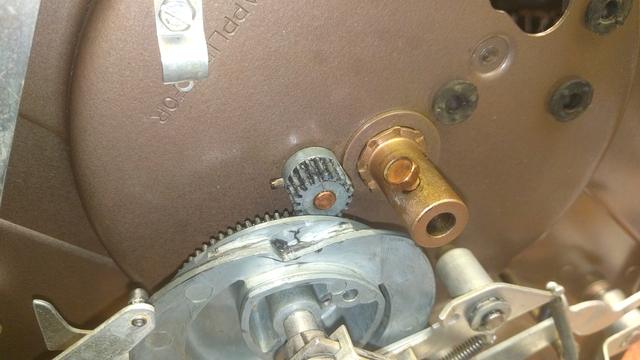
And here is the plastic gear on the other end of the shaft
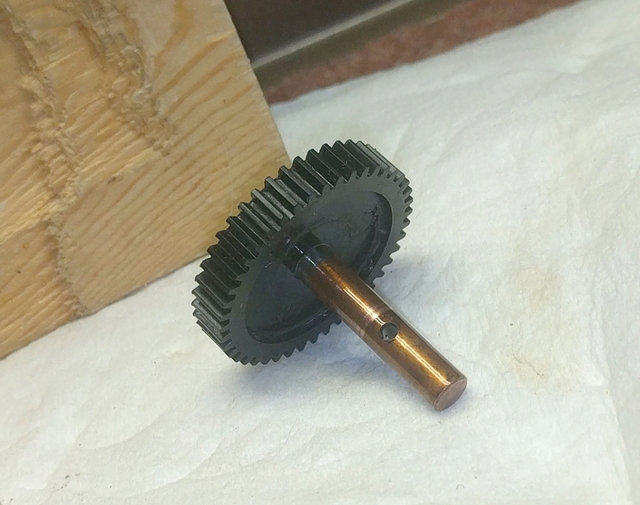
Now I have another question. Should I use oil on the shaft? Or should I use grease?
Rich
(This post was last modified: 12-21-2018, 05:10 PM by criageek.
Edit Reason: Add question
)
Posts: 98
Threads: 2
Joined: Jul 2014
City: Eugene, OR
I would just good a good oil like Zoom Spout but you could use a bit of something like phonolube if you have it.
Posts: 4,862
Threads: 54
Joined: Sep 2008
City: Sandwick, BC, CA
I would use grease on gears, but see if you can find the Philco service info on what to lube, and with what first.
Regards
Arran
Posts: 182
Threads: 5
Joined: Feb 2017
City: Cedar Rapids Iowa
Thanks guys! I know to use grease on gears. I'm wondering what to use on the shaft that the metal pinion gear is attached to. I would post pictures of grease I'm using but my cable and internet have been down since Saturday night and won't be back until Wednesday afternoon...I'm at my Mom's place now (how is it that cable/internet is easily my most expensive utility, yet they are the worst at customer support??). I know I'm using 3-In-1 household oil, but don't remember the brand of grease. Wait...I bought it on Amazon...here it is:
https://www.amazon.com/Sta-Lube-SL3141-M...ube+SL3141
Rich
(This post was last modified: 12-24-2018, 01:07 PM by criageek.)
Posts: 599
Threads: 24
Joined: Jan 2014
City: Edmonton AB CA
Anywhere there is a shaft and bushing you should use an oil. In the old days a lite motor oil like 10W or 20W was recommended. The problem with those oils is after many years they get thick and gooey and don't lubricate any more. I have gone with a lite synthetic that is not ever supposed to get gooey but time will be the test of that claim.
Gregb
Posts: 182
Threads: 5
Joined: Feb 2017
City: Cedar Rapids Iowa
I guess it's time for me to get back to trying to figure out why the FM doesn't work. I set it aside for a while and worked on the cabinet and the record changer.
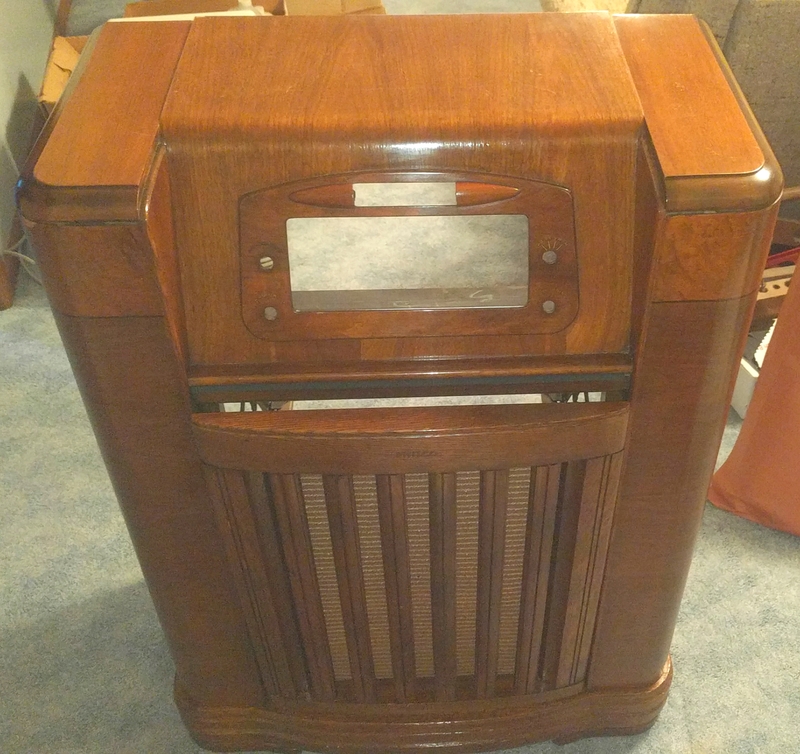
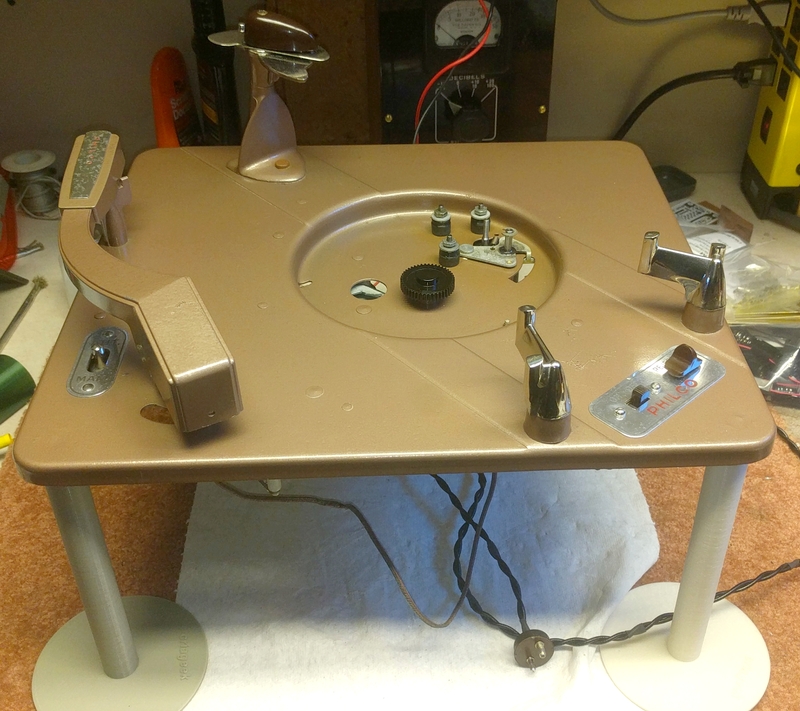
I just ordered an idler and a needle for the record changer so once they get here I'll get them installed and go through the setup procedure for the phono and give it a test.
Once that's done all that remains is getting the FM to work. I subscribe to Jim Lindenas' YouTube channel ( https://www.youtube.com/channel/UCbi8mX2...YIxaIsl-lg) and have seen him use an SDR (software defined radio) many times to gather information and do troubleshooting. So I decided to order one...it looks like it should be here in a few days. Once I get it set up and tinker with it a bit my plan is to use it to see if I can find the FM local oscillator running and go from there. As a shot in the dark I may order new 7F8, 6AG5, and 7X7 tubes, as they all could have an effect on the FM. Back when I first started this project I did get all new tubes, so I'm skeptical about it being a tube problem.
Rich
Users browsing this thread: 6 Guest(s)
|
|
Recent Posts
|
|
Zenith H725
|
| Here's what the inside of AM IFT2 looked like, and the other pic shows the discs I made to take place of the mica and ke...EdHolland — 07:40 PM |
|
Zenith H725
|
| IF2 will need replacement caps. The arcing was severe enough that the mica is pitted and holed where the HT flashed over...EdHolland — 04:04 PM |
|
My Philco 37-116 Restore
|
| Measuring from center tap like the tube voltages show. Cap 127 is isolated from ground. Cap 127 shown in upper left of p...dconant — 08:05 AM |
|
My Philco 37-116 Restore
|
| Are you measuring relative to the centertap or the GND?morzh — 11:57 PM |
|
Philco 610B oscillator wiring
|
| Still not clear on the wiring interface between the 6A7 and oscillator. After refering to the available schematics and s...Tubester — 07:18 PM |
|
Refinishing Ideas
|
| My 37-116 code 121 is the best sounding radio i have...a daily driver. Since we are talking about "changes". ...poulsbobill — 07:18 PM |
|
My Philco 37-116 Restore
|
| Hello, I finally got brave enough to take the cans off the Expander Unit. Got the grid cap wires replaced and back toget...dconant — 06:50 PM |
|
Zenith H725
|
| I got into the first AM IF can today, and found its mica was cracked. Amazing that it was still working. This one makes ...EdHolland — 06:10 PM |
|
Philco model #20
|
| AHH HA , I got it and can’t thank you fellows enough , when I changed the capacitors I took the advice and did not unsol...onlyrick — 02:24 PM |
|
Zenith H725
|
| Hello Ed,
yes, I like letting projects run for few days to make sure they don't start acting up .
Sincerely Richardradiorich — 01:03 PM |
|
Who's Online
|
| There are currently no members online. |

|
 
|



![[-] [-]](https://philcoradio.com/phorum/images/bootbb/collapse.png)


